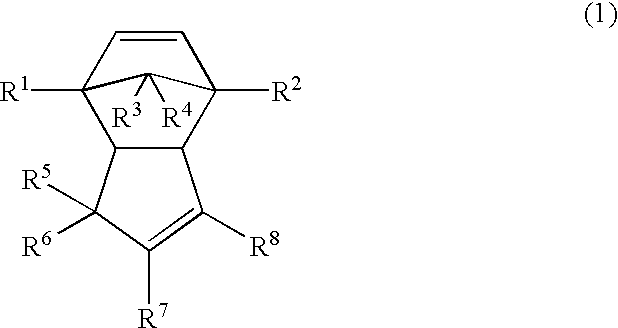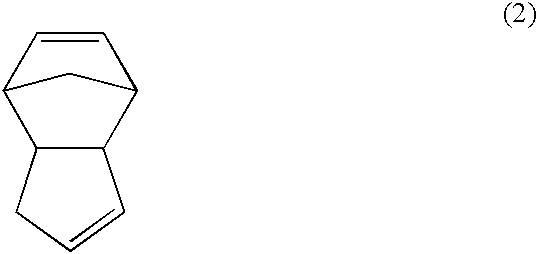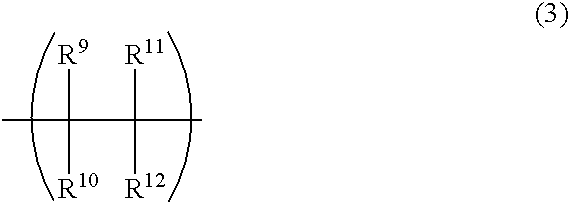Thermoplastic dicyclopentadiene-base open-ring polymers, hydrogenated derivatives thereof, and processes for the preparation of both
a technology of dicyclopentadiene and open-ring polymers, which is applied in the direction of filament/thread forming, synthetic resin layered products, textiles and paper, etc., can solve the problems of mechanical strength degradation of thermoplastic dcp ring-opening polymers, and achieve the improvement of heat resistance, processability, and resistance of present inventions.
- Summary
- Abstract
- Description
- Claims
- Application Information
AI Technical Summary
Benefits of technology
Problems solved by technology
Method used
Image
Examples
example 1
5 Grams of tricyclo[4.3.1.sup.2,6. 0.sup.1,6 ]deca-3,7-diene (dicyclopentadiene(DCP), manufactured by Nippon Zeon Co., Ltd., purity: 95% by weight or higher) (hereinafter referred to as "initial charge portion") and 120 g of cyclohexane were charged in a 1 liter flask the inner atmosphere of which was replaced with nitrogen, and 0.57 mmol of tri-i-butylaluminum (iBu.sub.3 Al) and 0.57 mmol of isobutyl alcohol (iBuOH) as polymerization catalysts, 0.189 mmol of acetone as a reaction regulator, and 3.79 mmol of 1-hexene as a molecular weight modifier were added to the flask. Thereto was added 0.086 mmol of tungsten hexachloride, followed by stirring at 70.degree. C. for 5 minutes. Then, with keeping the reaction system at 70.degree. C., a mixed liquid of 45 g of DCP (hereinafter referred to as "subsequent addition portion") and 0.103 mmol of tungsten hexachloride was continuously added dropwise over a period of 30 minutes (divided successive addition method) to the reaction system. Aft...
example 2
Ring-opening polymerization and hydrogenation were carried out in the same manner as in Example 1, except that methyl ethyl ketone (MEK) was used in place of acetone used in Example 1 as reaction regulator.
example 3
Ring-opening polymerization and hydrogenation were carried out in the same manner as in Example 1, except that acetone as the reaction regulator was previously mixed with tungsten hexachloride (hereinafter referred to as "premix addition method"), and 40% of the mixture was charged in the flask and 60% of the mixture was added to the system by division successive addition method in place of charging acetone in the flask (hereinafter referred to as "bottom addition method"), and the polymerization temperature was changed from 70.degree. C. to 40.degree. C.
PUM
| Property | Measurement | Unit |
|---|---|---|
| thickness | aaaaa | aaaaa |
| length | aaaaa | aaaaa |
| width | aaaaa | aaaaa |
Abstract
Description
Claims
Application Information
 Login to View More
Login to View More - R&D
- Intellectual Property
- Life Sciences
- Materials
- Tech Scout
- Unparalleled Data Quality
- Higher Quality Content
- 60% Fewer Hallucinations
Browse by: Latest US Patents, China's latest patents, Technical Efficacy Thesaurus, Application Domain, Technology Topic, Popular Technical Reports.
© 2025 PatSnap. All rights reserved.Legal|Privacy policy|Modern Slavery Act Transparency Statement|Sitemap|About US| Contact US: help@patsnap.com



